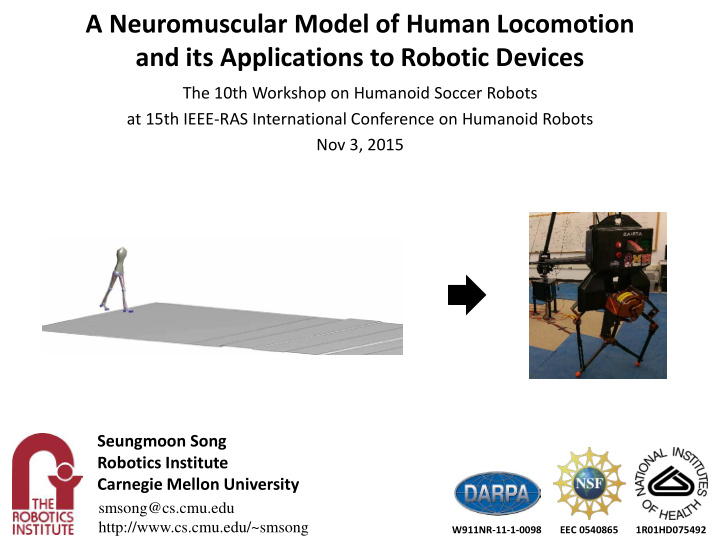



A Neuromuscular Model of Human Locomotion and its Applications to Robotic Devices The 10th Workshop on Humanoid Soccer Robots at 15th IEEE-RAS International Conference on Humanoid Robots Nov 3, 2015 Seungmoon Song Robotics Institute Carnegie Mellon University smsong@cs.cmu.edu http://www.cs.cmu.edu/~smsong W911NR-11-1-0098 EEC 0540865 1R01HD075492
How does human walk? S Song, Y Ryoo, and D Hong, Development of an omnidirectional walking engine for full-sized lightweight humanoid robots, ASME IDETC , 2011.
Geyer Group Hartmut Geyer
Content Background Neuromuscular model of human locomotion Using the model to control bipedal robots 1/19
Current understanding of human locomotion control Human locomotion is well described at the behavioral level Kinematics, dynamics, muscle activations, … Not much is understood at the neural circuit level Spinal and supraspinal control layers Central pattern generators (CPGs), reflexes, … 2/19
Simulation studies may provide better understanding + robust 3D locomotion pros cons + diverse locomotion behaviors + predictive model 3/19
Background Neuromuscular model of human locomotion S Song and H Geyer, A neural circuitry that emphasizes spinal feedback generates diverse behaviors of human locomotion, The Journal of Physiology , 2015. Using the model to control bipedal robots 4/19
Musculoskeletal system 7 segments 8 DOFs 22 MTUs CE: contractile element SE: series elasticity PE: parallel elasticity 5/19
Neurophysiological transmission delays are modeled Neural transmission delay Other sources of system delay muscle dynamics excitation-contraction coupling (ECC): ~35 ms 10 + 15 + 15 + 10 = 50 ms 6/19
Spinal control consists of reflex modules that embed key functions essential for legged locomotion Stance Stance Swing Swing Compliant leg behavior realizes walking and running [Geyer EA, 2003] Positive force feedback [Desai EA, 2012&2013; Song EA 2013] F cntr generates compliant leg F ipsi behavior [Geyer EA, 2006] LIPM [Kajita EA, 2001] SIMBICON [Yin EA, 2007] 7/19
Energy optimal control parameters generates human-like walking The neural control is plausible The neural control predicts normal human locomotion 8/19
Energy optimal walking shows human-like muscle activation Human Model The differences come from … - simplified musculoskeletal model - energy optimal control parameters 9/19
The model can generate diverse locomotion behaviors Robust walking (±10 cm) Slope ascend and descend 10/19
The model can generate diverse locomotion behaviors Speed change 0.8 ms -1 1.8 ms -1 1.8 ms -1 0.8 ms -1 Direction change Obstacle avoidance 10/19
S Song and H Geyer, A neural circuitry that emphasizes spinal feedback generates diverse behaviors of human locomotion, The Journal of Physiology , 2015. The proposed model can generate human-like robust walking and diverse locomotion behaviors The motor patterns of many human locomotion behaviors can be generated by chains of reflexes in the lower layer controller The model is implemented in MATLAB Simulink The model can be downloaded from: http://www.cs.cmu.edu/~smsong/nmsModel/nmsModel.html 11/19
Our neuromuscular model has been used in different studies Controllers for prosthetic legs and bipedal robots BionX (BiOM) EPFL (COMAN) GeyerGroup GeyerGroup [Eilenberg EA, 2010] [van der Noot EA, 2015] [Schepelmann EA, 2015] [Thatte EA, 2015] Simulation testbeds for assistive devices Controllers for graphical characters Delft Univ. Samsung GeyerGroup Stanford Univ. Utrecht Univ. [van Dijk EA, 2013] [Seo EA, 2015] [Thatte EA, 2015] [Wang EA, 2012] [Geijtenbeek EA, 2013] 12/19
Background Neuromuscular model of human locomotion Using the model to control bipedal robots Z Batts, S Song, and H Geyer, Toward a virtual neuromuscular control for robust walking in bipedal robots, IEEE IROS , 2015. 13/19
Current robot walking controllers have not yet reached the robustness of human locomotion control Centralized controllers Heuristic policy-based controllers [Urata EA, 2012] [Feng EA, 2014] [Raibert EA, 2008] [Nelson EA, 2012] 14/19
The reflex-based neuromuscular control may provide an alternative controller Virtual neuromuscular control (VNMC) ATRIAS robot - human size - trunk mass: 58 kg, leg mass: 2 kg (x 2) - no foot - series elastic actuators (SEA) 15/19
With VNMC, ATRIAS can walk on a terrain with height changes of ±20 cm in a 2D simulation environment 16/19
The stance leg control is tested on hardware 17/19
Other Applications Nitish Thatte – Controller and simulation testbed for prosthetic legs N Thatte and H Geyer, Toward balance recovery with leg prostheses using neuromuscular model control, IEEE Transactions on Biomedical Engineering , 2015. vs. impedance control [Sup EA 2008] 18/19
Other Applications – Simulation testbed for studying foot biomechanics S Song and H Geyer, The energetic cost of adaptive feet in walking, IEEE ROBIO , 2011. S Song, C LaMontagna, SH Collins, and H Geyer, The effect of foot compliance encoded in the windlass mechanism on the energetics of human walking, IEEE EMBC , 2013. 18/19
Controller for robotic platforms Simulation testbed for locomotion studies The model can be downloaded from: smsong@cs.cmu.edu http://www.cs.cmu.edu/~smsong/nmsModel/nmsModel.html
Recommend
More recommend